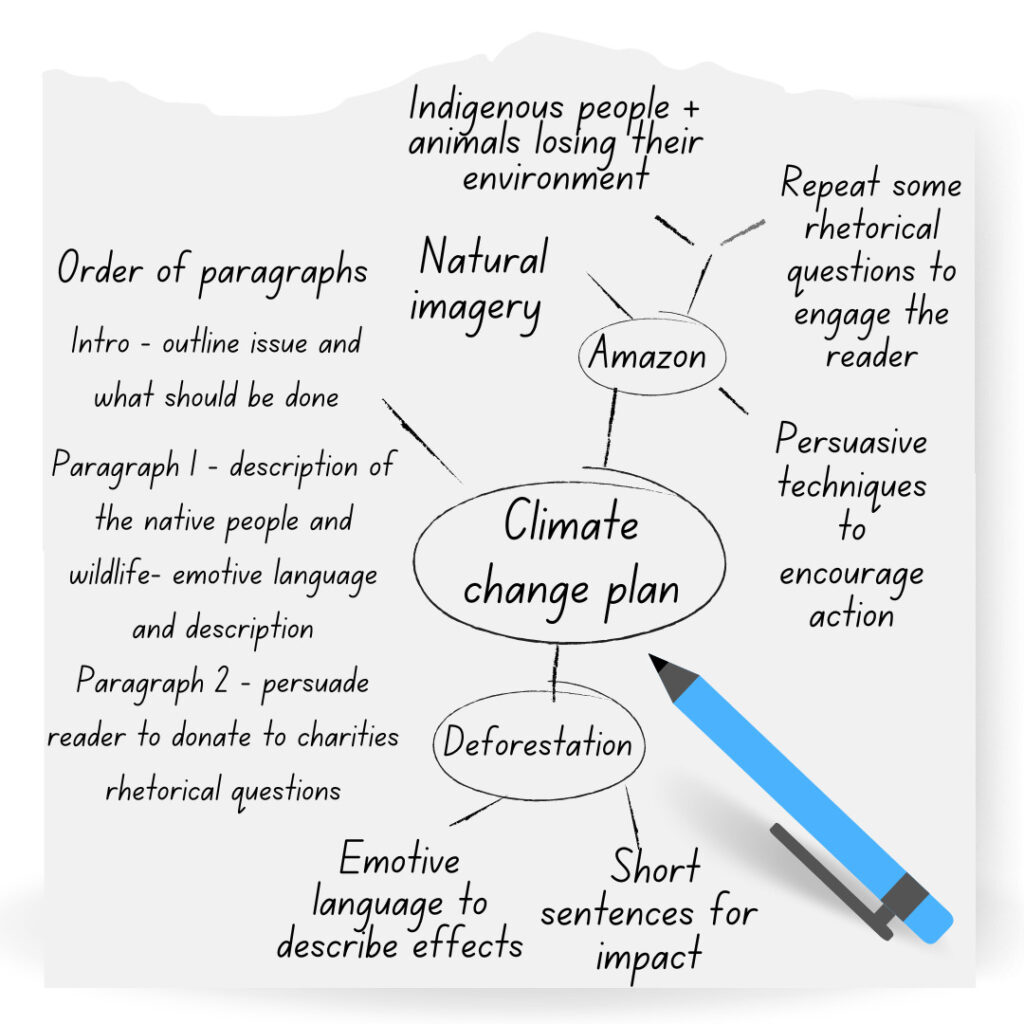Writing: Crafting Creative Writing
Writing: Crafting Creative Writing Revision
Crafting Creative Writing
By the end of this page you should know how to respond effectively and efficiently to the writing section tasks in your GCSE exam.
We will learn what’s in the mark scheme, how to plan your answer, and how to give you a few structuring ideas so you understand what the examiner is looking for.
What Are You Being Tested On?
There are only two Assessment Objectives in the writing portion of the exam.
You may remember them from our previous pages…
AO5 and AO6!
Let’s have a refresher of what these two objectives entail.
AO5
From the mark scheme:
- Students should aim to communicate clearly, effectively and imaginatively.
- They can select and adapt their tone, style and register for different forms, purposes and audiences.
- Students are able to organise information and ideas, by using structural and grammatical features to support their coherence.
AO6
From the mark scheme:
- Students should use a range of vocabulary and sentence structures for clarity, purpose and effect in their writing.
- Students should have consistently accurate spelling and punctuation.
How to Plan your Answer
Thinking about themes:
By the time you get to the writing question, you will actually already have been given clues as to what the theme of this question will be!
Questions in a paper are usually under one theme.
For example:
If the questions from the reading section of Paper 1 focuses on ‘Oliver Twist‘ by Charles Dickens, the question might ask you to write a story inspired by the word ‘alone’.

Putting pen to paper:
Make a note of some key words or ideas that come up once you’ve read the question through properly.
For example:
If the focus is on climate change you might write pollution, deforestation, fire, smoke.
Here you can pull out themes or repeated ideas you find interesting or can develop into a creative piece.
In this example, you might write about a deforested section of the Amazon, using language techniques to describe fire and smoke, or presenting climate change in an emotive context.
Think about the individual parts of the question and which angles you could take. Some exam boards, including AQA, will give you an image for example, so you could use this to form the basis of your writing.
This will grab the examiner’s attention by showing that you are able to respond to a prompt and engage in specific questions creatively.
On the other hand, other exam boards, such as Edexcel, might ask for a time in your life when a particular event, which is relevant to the theme, took place.
This does not have to be based on your real life, but you should still aim to make it as interesting as possible.

Who are you writing for?
In some cases, the question may give you a hint as to who your audience is. For example, it may ask you to ‘write an article for a local magazine‘ or ‘write a letter to your local MP‘.
Once you know the intended audience of your writing, you can decide on the tone and register you should use.
For example, in an article for a local magazine, you might use more informal language, whereas to the MP, you would use a more formal register.
The format will also be dictated, here it’s an article or a letter. You should be familiar with the formatting for a variety of texts before your exam, but we will go through these in depth in the next box!
Why are you writing?
The question may also give you clues about the purpose and aim of your writing, for example ‘write a letter to your local council to complain about the noise levels in your area.’
In instances like this, you would then think about persuasive language techniques you could use in your writing, including emotive language or rhetorical questions for example.
Structuring
In a creative writing question where you have more free reign, like a story or description, there are different ways to experiment with structure.
- The basic story arc of beginning, middle and end that you may already be familiar with can be subverted, through a different perspective than the expected main character.
- Or the perspective could shift halfway through to give another character’s opinions on the event, creating interest for the reader and showcasing your skills to the examiner!
- Starting the story at the climax of action is a creative way to switch up the structure of your entire answer. You could work backwards and then explain the events that led up to the climax, or describe the aftermath in detail.
If the question specifies a format, like a letter or article, you should use the appropriate structural techniques.

Letter Structure
A letter typically takes a formal tone.
You should include an appropriate greeting: ‘Dear Sir/Madam‘
You should also include an appropriate sign-off: ‘Yours faithfully‘ if you don’t know who the recipient is, ‘Yours sincerely’ if you do know.
If the letter is to a known audience, you could take a more friendly tone and use first names, e.g., ‘Dear Mohammed‘. Your sign-off could match this tone, e.g., ‘Best wishes‘.
You should also include the address of the person sending the letter in the top right corner of the page, the address of the person receiving the letter in the top left corner of the page, but slightly underneath the first (these can be made up).

Article Structure
An article should include an engaging headline, which could be an exclamation or question for example.
A strapline is a small line of text under the headline that offers more information on the topic or idea that the headline introduced initially.
Subheadings can be used to organise information in your article. You could make them interesting by adding humour or a rhetorical question to grab the reader’s attention. They should give the reader an idea of what the next paragraph will be about.
Your article should also have a date, and author attribution, e.g., ‘by David Smith, 25th May 2022‘.
Checking Your Answer
It’s a good idea to leave at least five minutes at the end of the exam to check over your answer.
Read through it carefully and make your improvements neatly if needed.
Some questions to think about are:
Could a more sophisticated word choice replace something already there?
- An important part of AO5 and AO6 is using a wide range of sophisticated language, so try to think of some creative swaps for simple words.
Have you got any repeated points that you could remove?
- AO5 requires you to be concise and clear in your communication, which is hindered by repetition of points. Once you have made a point, try to develop it further by asking what happens next? What is the impact on the people or things in your writing?
Is your spelling and grammar correct?
- Ensuring the sophisticated language you use is spelled correctly is essential to get the 16 marks available for AO6 in these questions. Check out our more detailed SPaG pages for more information on common mistakes you might make in the exam, and how to fix them!
Is your punctuation placed right?
- Don’t just stick to full stops and commas in your writing. As long as you use it correctly, get creative with the types of punctuation you use in your answer for a higher AO6 mark. For example, exclamation marks and question marks to create a more conversational tone between the author and the reader. Hyphens, brackets and colons are just a few more you can use in the exam for effect.

MME Premium Membership
£19.99
/monthLearn an entire GCSE course for maths, English and science on the most comprehensive online learning platform. With revision explainer videos & notes, practice questions, topic tests and full mock exams for each topic on every course, it’s easy to Learn and Revise with the MME Learning Portal.
Sign Up Now


